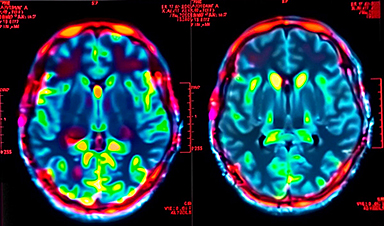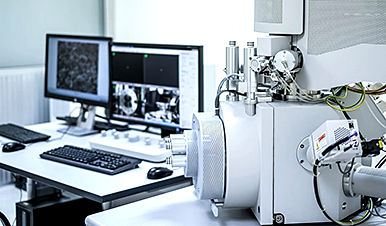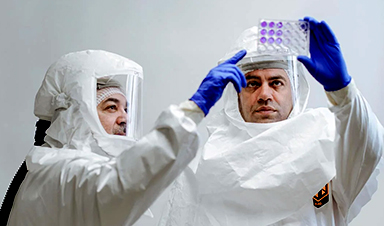One of the most common COVID-19 tests involves a long swab pressed deep into the nasal cavities – and while the test can be administered quickly, it has been described as unpleasant and uncomfortable.
Now researchers at The Ohio State University are working on a testing system that would require a simple exhaled breath. Perena Gouma is the primary investigator of a team developing a breathalyzer device that will sample breath for key biomarkers of the infection. She says it would serve as an alternative to current tests that are expensive, can take a long time to get results and require specialized personnel to do the sampling and to analyze the results.
Gouma, director of the Advanced Ceramics Research Laboratory and professor in the College of Engineering, is working with co-investigator Andrew Bowman, associate professor of veterinary preventive medicine. The project was awarded a nearly $200,000 National Science Foundation EAGER grant this month under a program supporting exploratory, early-stage research on untested, but potentially transformative, ideas or approaches.
“Breath analysis is not really a technique that is used widely in the medical field yet, so it is considered early-stage work,” Gouma said. “[We] have a sensor device that detects nitric oxide and VOCs (volatile organic compounds) in breath and can be used to tell you about the onset of an infectious disease.”
In addition to nitric oxide, the device examines two other metabolites that could specifically indicate the presence of a COVID-19 infection even in asymptomatic patients. Exhaling once in the breathalyzer may help with earlier detection of the onset of the disease, as well as with monitoring of the severity of the infection, which could help reduce the risk for worsening of the symptoms and allow timely therapeutic intervention, she said.
The new project builds upon Gouma’s invention of a hand-held breath monitor that may provide early detection of flu before symptoms appear prior to her arrival at Ohio State. The COVID-19 breathalyzer involves advances on nanomaterials for detecting specific breath gases at the concentrations of interest for making a diagnosis.
The breathalyzer gives results rapidly (15 seconds response time), it is extremely inexpensive, and it is easy to use so that there is no need for trained personnel to perform the test, Gouma said. The results can be viewed directly on the display or they can be transferred to the physician wirelessly.
“We are working on making these hand-held monitors that will be widely distributed and they’re very inexpensive,” she said. “The technology evolved from the sensors used for monitoring gases in an automotive exhaust – that’s how we started on breath analysis 20 years ago.”
Image Credit: NIAID/NIH/SPL
![]()
News This Week
Does COVID increase the risk of Alzheimer’s disease?
Scientists discover that even mild COVID-19 can alter brain proteins linked to Alzheimer’s disease, potentially increasing dementia risk—raising urgent public health concerns. A recent study published in the journal Nature Medicine investigated whether both mild and [...]
New MRI Study Reveals How Cannabis Alters Brain Activity and Weakens Memory
A massive new study sheds light on how cannabis affects the brain, particularly during cognitive tasks. Researchers analyzed over 1,000 young adults and found that both heavy lifetime use and recent cannabis consumption significantly reduced brain [...]
How to Assess Nanotoxicity: Key Methods and Protocols
With their high surface area and enhanced physicochemical properties, nanomaterials play a critical role in drug delivery, consumer products, and environmental technologies. However, their nanoscale dimensions enable interactions with cellular components in complex and [...]
Nanotech drug delivery shows lasting benefits, reducing need for repeat surgeries
A nanotechnology-based drug delivery system developed at UVA Health to save patients from repeated surgeries has proved to have unexpectedly long-lasting benefits in lab tests – a promising sign for its potential to help human patients. [...]
Scientists Just Found DNA’s Building Blocks in Asteroid Bennu – Could This Explain Life’s Origins?
Japanese scientists detected all five nucleobases — building blocks of DNA and RNA — in samples returned from asteroid Bennu by NASA’s OSIRIS-REx mission. NASA’s OSIRIS-REx mission brought back 121.6 grams of asteroid Bennu, unveiling nitrogen-rich organic matter, including DNA’s essential [...]
AI-Designed Proteins – Unlike Any Found in Nature – Revolutionize Snakebite Treatment
Scientists have pioneered a groundbreaking method to combat snake venom using newly designed proteins, offering hope for more effective, accessible, and affordable antivenom solutions. By utilizing advanced computational techniques and deep learning, this innovative [...]
New nanosystem offers hope for improved diagnosis and treatment of tongue cancer
A pioneering study has unveiled the Au-HN-1 nanosystem, a cutting-edge approach that promises to transform the diagnosis and treatment of tongue squamous cell carcinoma (TSCC). By harnessing gold nanoparticles coupled with the HN-1 peptide, [...]
Global Trust in Science Is Stronger Than Expected – What’s Next?
A landmark global survey conducted across 68 countries has found that public trust in scientists remains robust, with significant support for their active involvement in societal and political matters. The study highlights the public’s [...]
Microplastics in the bloodstream may pose hidden risks to brain health
In a recent study published in the journal Science Advances, researchers investigated the impact of microplastics on blood flow and neurobehavioral functions in mice. Using advanced imaging techniques, they observed that microplastics obstruct cerebral blood [...]
AI Surveillance: New Study Exposes Hidden Risks to Your Privacy
A new mathematical model enhances the evaluation of AI identification risks, offering a scalable solution to balance technological benefits with privacy protection. AI tools are increasingly used to track and monitor people both online [...]
Permafrost Thaw: Unleashing Ancient Pathogens and Greenhouse Gases
Permafrost is a fascinating yet alarming natural phenomenon. It refers to ground that remains frozen for at least two consecutive years. Mostly found in polar regions like Siberia, Alaska, and Canada, permafrost plays a [...]
Frequent social media use tied to higher levels of irritability
A survey led by researchers from the Center for Quantitative Health at Massachusetts General Hospital and Harvard Medical School has analyzed the association between self-reported social media use and irritability among US adults. Frequent [...]
Australian oysters’ blood could hold key to fighting drug-resistant superbugs
Protein found in Sydney rock oysters’ haemolymph can kill bacteria and boost some antibiotics’ effectiveness, scientists discover An antimicrobial protein found in the blood of an Australian oyster could help in the fight against [...]
First U.S. H5N1 Death Sparks Urgency: Scientists Warn Bird Flu Is Mutating Faster Than Expected
A human strain of H5N1 bird flu isolated in Texas shows mutations enabling better replication in human cells and causing more severe disease in mice compared to a bovine strain. While the virus isn’t [...]
AI Breakthrough in Nanotechnology Shatters Limits of Precision
At TU Graz, a pioneering research group is leveraging artificial intelligence to drastically enhance the way nanostructures are constructed. They aim to develop a self-learning AI system that can autonomously position molecules with unprecedented precision, potentially [...]
How Missing Sleep Lets Bad Memories Haunt Your Mind
Research reveals that a lack of sleep can hinder the brain’s ability to suppress unwanted memories and intrusive thoughts, emphasizing the importance of restful sleep for mental health. Sleep deprivation has been found to [...]























